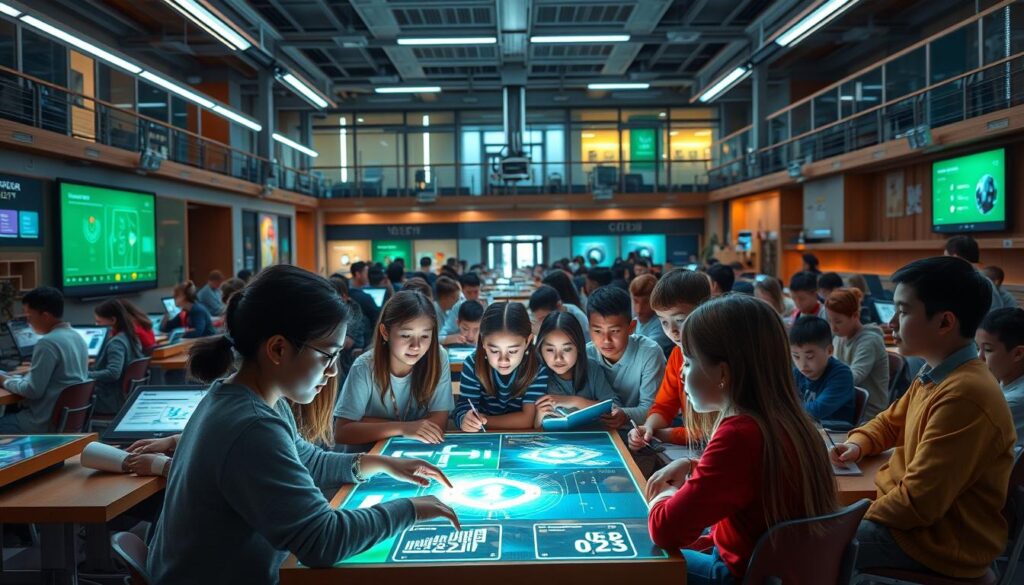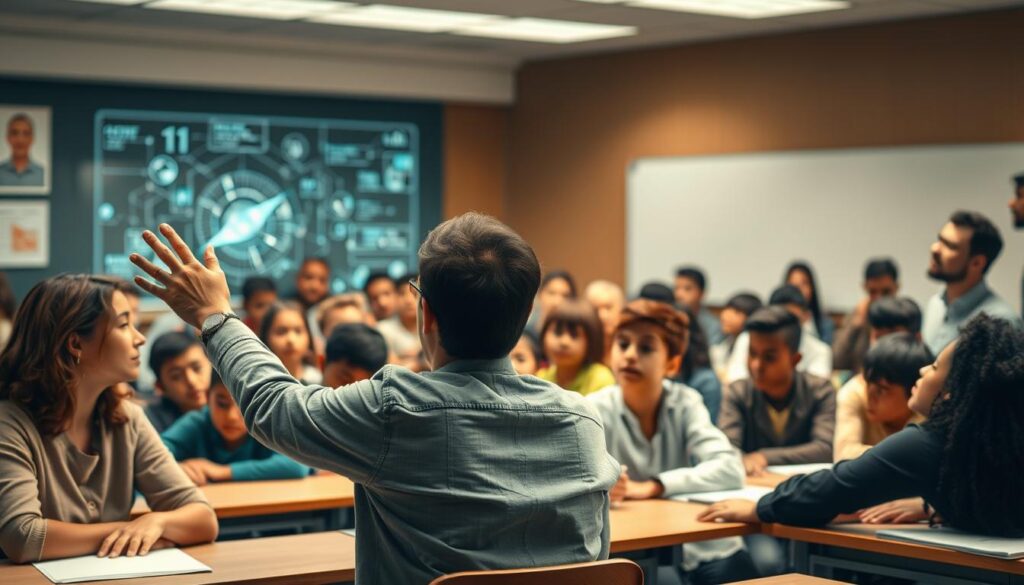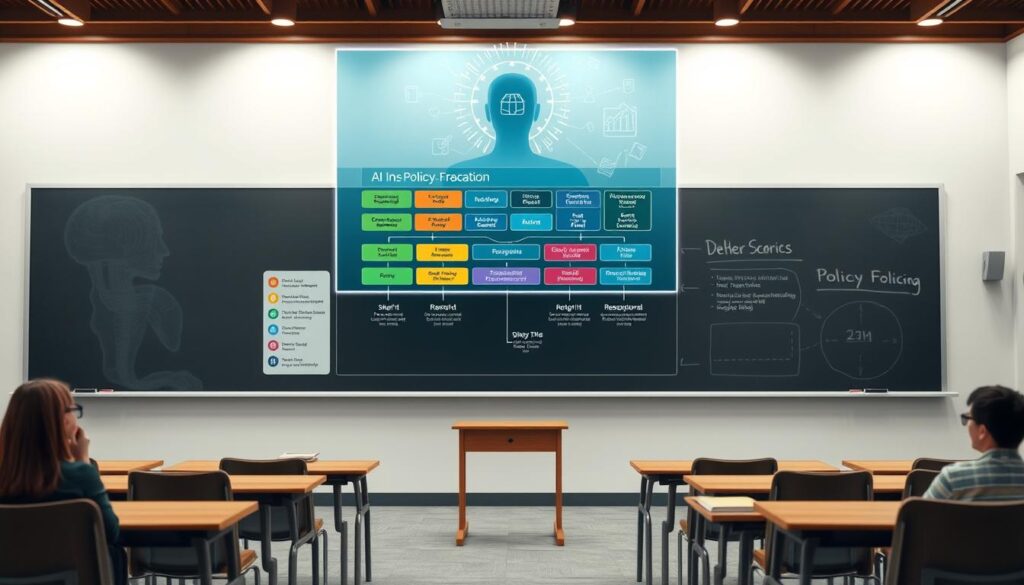Using AI for Education
Did you know 92% of teachers who’ve tried AI-powered tools report improved student engagement? Artificial intelligence isn’t just for tech companies anymore—it’s quietly revolutionizing how we learn. From personalized tutoring systems to automated grading, these innovations are creating waves in schools across America.
Classrooms now use smart algorithms to identify learning gaps faster than ever. Students interact with adaptive platforms that adjust difficulty levels in real time, while educators gain insights to refine their teaching strategies. Even homework looks different, with tools providing instant feedback that used to take hours.
But this shift brings big questions. How do we balance tech with human connection? What safeguards protect student data? This exploration dives into real-world examples where schools successfully blended artificial intelligence with traditional methods—without losing the heart of education.
Key Takeaways
- Smart technology adapts lessons to individual student needs in real time
- Teachers save 6+ hours weekly using automated grading systems
- Over 40% of U.S. high schools now use some form of AI-powered tutoring
- Data privacy remains a top concern for parents and administrators
- Hybrid models combining AI and human instruction show the best results
Overview of AI’s Role in Modern Education

Classrooms nationwide now hum with algorithms that adapt faster than chalkboards ever could. A 2024 study reveals 83% of K-12 instructors use smart systems today—up from 51% just two years prior. Meanwhile, college learners embrace these resources twice as often as professors, reshaping how knowledge flows between generations.
This tech infusion spans every grade level. Elementary schools deploy interactive math tutors that adjust to skill gaps. Universities employ writing assistants offering real-time grammar fixes. “These systems don’t replace teachers—they amplify their superpowers,” notes a Denver middle school principal.
| User Group | Adoption Rate | Primary Use |
|---|---|---|
| K-12 Teachers | 83% | Lesson planning & grading |
| College Students | 49% | Research & assignments |
| University Faculty | 22% | Course design |
Personalized learning paths now help struggling readers catch up while challenging advanced learners. Districts report higher test scores where human educators and machines collaborate. The key? Balancing silicon efficiency with classroom warmth.
As acceptance grows, schools prioritize training for both staff and pupils. The goal: harness these tools ethically while preserving the magic of face-to-face mentorship.
Understanding Artificial Intelligence in Education

At its core, artificial intelligence acts as a dynamic partner in learning. These systems analyze data faster than any human could, spotting trends in how students grasp concepts. Think of them as digital teaching assistants that never sleep—always ready to adjust lessons or flag areas needing attention.
One standout feature? Pattern recognition. Smart tools track everything from quiz scores to how long someone stares at a math problem. This helps teachers understand why a student might struggle with fractions but ace geometry. For multilingual learners, language-processing features break down barriers by explaining terms in simpler words or multiple dialects.
Content creation gets a boost too. Imagine history textbooks that automatically include local landmarks when teaching civil rights. Or science modules that generate 3D models of cells for visual learners. “It’s like having a curriculum designer in every classroom,” shares a Texas middle school teacher.
Predictive capabilities transform support systems. Algorithms can now guess which eighth-graders might need extra algebra help months before final exams. Schools using these alerts report 30% fewer course failures. Best part? The tech keeps evolving as it encounters new teaching scenarios—always learning, always adapting.
The Current State of AI in Teaching and Learning
Classrooms now operate with three powerful technological allies: reactive, predictive, and generative systems. These tools work behind the scenes, transforming how knowledge gets delivered and absorbed. A fall 2023 survey showed 74% of districts reported using at least one type in daily instruction.
Reactive, Predictive, and Generative AI Explained
Reactive systems answer immediate needs. Voice assistants like Siri help students with quick facts during lessons. Predictive models analyze past performance—think math programs guessing which algebra concepts might trip up ninth-graders next month.
Generative tools create fresh content. History teachers get customized primary source activities in minutes. “It’s like having a teaching partner who knows every curriculum standard,” says a Michigan high school educator.
Real-World Applications in Schools and Campuses
Four approaches dominate classrooms today:
- Student-focused: Adaptive tutors adjust difficulty mid-lesson
- Teacher-focused: Automated rubrics grade essays 5x faster
- Institution-focused: Safety scanners monitor campus communications
- System-focused: Budget algorithms allocate resources fairly
Research from UCLA reveals schools blending these methods see 18% higher test scores. Students using writing assistants submit polished drafts sooner, while teachers reclaim hours previously spent on administrative tasks. The key lies in matching the right tool to each learning challenge.
Benefits of AI in Education

What if every student had a personal tutor available 24/7? Smart systems now make this possible through adaptive learning paths that shift based on individual progress. These intelligence tools analyze how students solve problems, then adjust difficulty levels before frustration sets in.
Real-time feedback transforms how learners grow. Instead of waiting days for graded papers, pupils instantly see where they excel and where concepts need review. “It’s like having a coach whispering guidance during practice,” explains a Maryland math teacher using these platforms.
Educators gain hours weekly through automated tasks. Tools like Eduaide craft lesson plans in minutes, while Quizzizz generates practice tests tailored to class needs. This efficiency lets teachers focus on creative instruction rather than paperwork.
Inclusive design shines through features like speech-to-text converters and visual learning aids. Students with dyslexia can access textbook content through audio versions, while image generators turn abstract ideas into memorable diagrams. Districts report 42% fewer accommodation requests since adopting these solutions.
The potential extends beyond classrooms. Platforms like Curipod spark critical thinking through debate prompts crafted by algorithms. Learners practice analyzing AI-generated arguments—a skill becoming vital in our tech-driven world.
These advancements create new ways to engage diverse minds while preserving the irreplaceable human touch. When silicon efficiency meets educational passion, both teachers and students win.
Challenges and Concerns with AI in the Classroom

Not all that glitters is gold—smart classroom tools face critical tests. While these systems offer personalized learning, they also raise important questions about fairness and human connection.
Privacy, Security, and Bias in Algorithms
Schools collect mountains of student data, from quiz scores to reading habits. A 2023 Stanford study found 58% of non-native English essays got wrongly flagged as machine-written. “Our tools struggle with cultural nuances,” admits a language arts teacher from Chicago.
| Writer Type | Detection Accuracy | Common Errors |
|---|---|---|
| Native English | 94% | Rare false positives |
| Non-Native English | 47% | Style misclassification |
| Bilingual Students | 63% | Code-switching issues |
Security risks multiply as schools adopt cloud-based platforms. One district reported 12 data breaches last year involving student records. Parents increasingly ask: “Who’s watching the watchers?”
Impact on Human Interaction and Academic Integrity
Overloaded systems can strain teacher-student bonds. A recent survey shows 41% of learners feel less connected to instructors using automated grading. Meanwhile, tech-savvy pupils exploit essay generators—89% of cheaters avoid detection according to one campus trial.
Cost barriers create uneven playing fields. Wealthy districts spend $15,000/year on advanced systems, while others rely on free tools with limited features. This gap affects 23% of Title I schools according to Department of Education reports.
“We need guardrails, not roadblocks—technology should empower without excluding.”
Policy and Implementation: Navigating AI Regulations

School districts face a maze of regulations as they adopt new classroom technologies. While some states provide clear roadmaps, others leave decision-making to local leaders—creating a patchwork of approaches nationwide.
State Guidelines and Institutional Policies
Sixteen states have stepped forward with official guidance, from California’s detailed integration plans to Utah’s pilot programs. New York took a different path, banning facial recognition systems in schools entirely. “We’re building the plane while flying it,” admits a Connecticut district superintendent.
| State Approach | Examples | Impact on Districts |
|---|---|---|
| Comprehensive Guidance | California, Washington | Standardized training programs |
| Decentralized Policies | Tennessee, Ohio | Custom solutions per district |
| Tech-Specific Bans | New York | Limited tool availability |
Local implementation varies wildly. Los Angeles Unified created its own learning platform, while rural districts in Mississippi often lack resources to develop policies. 45% of teachers report receiving no formal training on approved tools.
Three key challenges emerge:
- Balancing innovation with student privacy protections
- Ensuring equal access across income levels
- Maintaining academic integrity with evolving tech
District leaders stress the need for ongoing policy updates. As one Texas school board member notes: “Last year’s rules can’t govern tomorrow’s tools—we need living documents.” The path forward requires collaboration between lawmakers, educators, and tech developers.
Innovative AI Applications in K-12 and Higher Education
Imagine middle schoolers studying wildlife through smart bird feeders that log species data. The University of Southern California’s Institute for Creative Technologies turns abstract concepts into tactile adventures. Their interactive exhibits let elementary learners program friendly robots using color-coded blocks—no coding experience needed.
Gamified Learning Breaks Barriers
The award-winning ARIN-561 game sends players across galaxies while teaching search algorithms. Ukrainian refugee students used this tool to master English and tech basics simultaneously. “It feels like play, but they’re solving real AI puzzles,” explains a Maine teacher using similar NSF-funded projects.
Schools now blend physical and digital experiences. AI avatars guide young children through story-based math challenges. High schoolers tackle university-level concepts via strategy games that adapt to their skill level. These hands-on applications prove complex ideas stick better when paired with curiosity and joy.
Districts report higher retention rates where tech-enhanced activities complement traditional lessons. As one developer notes: “When kids build their own intelligent tools, they remember the principles behind them.” This fusion of innovation and practicality prepares learners for tomorrow’s challenges while keeping education human-centered.
FAQ
How is artificial intelligence changing modern classrooms?
What are reactive, predictive, and generative AI models in education?
Are there privacy risks with AI tools in schools?
Can AI reduce human interaction in learning?
What policies guide AI use in U.S. schools?
How do K-12 schools use generative AI creatively?
Does AI help with teacher workloads?
How can schools address AI-generated cheating?

Sharon Molly is a content creator in lifestyle, fashion, and travel, delivering style-savvy advice and destination insights to inspire confident living. With a background in digital media, she combines aesthetics with practical guidance for modern women on the go.




